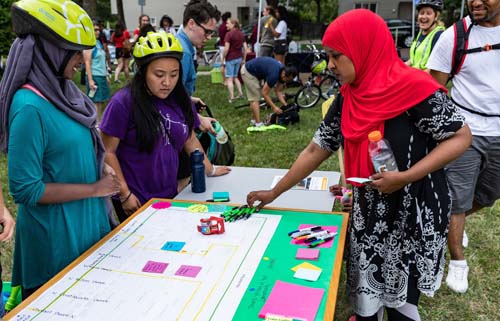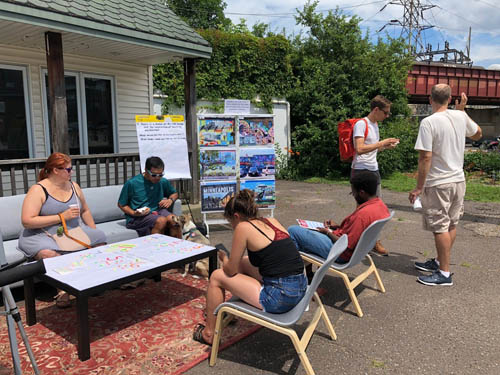Back in the 1960s, the Minnesota Highway Department’s construction of I-94 destroyed hundreds of homes and shattered a vibrant African American community ─ Rondo ─ leaving in its wake a legacy of distrust. The leadership of MnDOT, as the agency is now known, has apologized to the Rondo community and committed to improve relationships with communities in the I-94 corridor.
 Their project, Rethinking I-94, is a long-term effort to improve safety and reduce traffic congestion in a 15-mile stretch of the freeway in Minneapolis and Saint Paul. The foundation of the project is initiating and fortifying connections with the residents who live in the corridor.
Their project, Rethinking I-94, is a long-term effort to improve safety and reduce traffic congestion in a 15-mile stretch of the freeway in Minneapolis and Saint Paul. The foundation of the project is initiating and fortifying connections with the residents who live in the corridor.
Recognizing that community engagement needs to be flexible to meet the needs of constituencies, rather than oriented to the convenience of the organization leading the outreach, the Metropolitan Council collaborated with MnDOT to hire six community-based organizations to conduct authentic community engagement. The overall objective is to ensure that resident input informs transportation decisions.
The successful results of their work illustrate winning strategies to engage underrepresented constituents around infrastructure in a way that has not been done before.
Building on the capacity of community-based organizations
After a competitive vetting process, the Council in 2018 hired six nonprofits that had existing relationships with residents and businesses in the study area: Hope Community Inc., ReConnect Rondo, Rondo Avenue, Inc., Seward Redesign, MoveMN, and Union Park District Council. With contracts in the range of $20,000 to $38,000, these organizations facilitated connections with neighbors, advocacy groups and local businesses to delve deep into communities to listen and learn. The outcomes of their efforts established a foundation for future planning and project work on I-94.
Engaging people where they are in original ways
The project partners designed an impressive range of unique strategies to engage residents from the Phillips, West Bank, and Seward neighborhoods in Minneapolis; and the Rondo, Union Park, Midway, Frogtown, and Summit-University neighborhoods in Saint Paul.
 Union Park District Council engaged traditionally underrepresented community members in one-on-one conversations through the use of outdoor pop-up living rooms set up in specific locations along the corridor. They asked people to explore and express how they currently experience the I-94 corridor and ideas for possible improvements.
Union Park District Council engaged traditionally underrepresented community members in one-on-one conversations through the use of outdoor pop-up living rooms set up in specific locations along the corridor. They asked people to explore and express how they currently experience the I-94 corridor and ideas for possible improvements.
Hope Community Inc., held gatherings and facilitated conversations in three languages. These conversations began to uncover ways to repair past and current damage through community-oriented decisions.
ReConnect Rondo staff focused on the feasibility, planning, and research for a proposed Rondo Land Bridge to reconnect the communities along the I-94 corridor and the Rondo neighborhood of Saint Paul.
A nearby organization, Rondo Avenue Inc., held a series of events including the grand opening of the Rondo Commemorative Plaza. The plaza event drew hundreds of residents from the Summit-University and Frogtown neighborhoods, local elected officials, and MnDOT leadership.
Seward Redesign, Inc., staff established ties with residents from Seward and Cedar-Riverside, including immigrant organizations, and staff from government agencies to discuss pedestrian improvements. These engagement efforts, along with technical analysis, led to the design of a safe pedestrian crossing by Seward Tower West that is possible from an engineering perspective.
Move Minnesota collaborated with Urban Farm and Garden Alliance to launch the “Bridging a Path to Health” initiative. Staff developed games and activities, for example, Walking Bingo, where local residents walked together and made recommendations that would result in better connections across I-94 and minimize its harm on the people living there. Their comments reflected a desire for children to be able to bike safely to local destinations and improved access to green spaces.
Rethinking I-94 is now in its second phase
Since 2016, the Minnesota Department of Transportation (MnDOT) has been working with neighborhoods, community groups, district councils, local governments, and others interested in the future of I-94 between Saint Paul and Minneapolis in an effort to plan for transportation changes on and along the freeway.
In the second phase of work, MnDOT is:
-
Continuing its engagement with communities
-
Developing and evaluating alternatives for I-94
-
Identifying actions to address corridor needs
-
Preparing environmental documentation
More information about Rethinking I-94